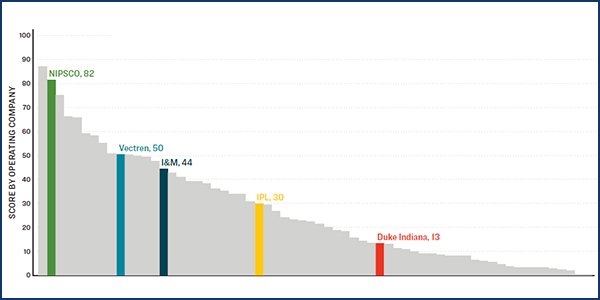Despite pledges to reduce emissions, many of the nation’s largest utilities plan to continue using coal and natural gas-fired generation through 2030, threatening efforts to mitigate climate change, the Sierra Club said in a report Monday.
The environmental group said U.S. utilities must eliminate coal and reduce greenhouse gas emissions by at least 80% by 2030 to limit global warming to 1.5 degrees Celsius (2.7 degrees Fahrenheit), the threshold many climate scientists say is crucial to avoiding the worst impacts of climate change.
“There are three key things utilities must do to enable us to avoid catastrophic warming: They must retire existing coal plants by 2030, terminate plans to build new gas plants and build clean energy much faster,” it said.
The study was based on a review of integrated resource plans and public announcements by the 50 utilities that hold the biggest fossil fuel generating fleets. The 50 companies, which include 79 operating companies, own half of all remaining coal and gas generation in the U.S.
“We find there is a stark difference between utilities’ existing coal and gas generation (1,310 million MWh) and how much clean energy they plan to add this decade (only 250 million MWh),” the group said. “In other words, despite 33 of these companies having a public climate goal, there is an enormous gap between utilities’ current practices and what they need to do to protect people and the planet.”
The companies in the study own 68% of remaining coal generation but have committed to retire only one-quarter of that capacity by 2030, the organization said.
The club noted that Duke Energy, Dominion Energy and Southern Co., which are responsible for more than 12% of the nation’s power sector carbon emissions, each have set corporate climate goals pledging to reach net-zero emissions by 2050. “Yet these companies’ investment plans include large amounts of new gas and lack adequate build-outs of clean energy. Duke and Southern Co. both score an ‘F’ in our analysis, and Dominion scores a ‘D.’ All three will miss their own decarbonization targets unless they change their plans.”
Southern Seeks ‘Orderly Transition’
Southern, which has promised to reduce its carbon emissions 50% by 2030 from a 2007 baseline, told RTO Insider that it was “embracing an orderly transition” of its coal fleet in a process that considers affordability, reliability, safety, environmental impacts and resilience. It said it expects 2020 to be the first time in modern history that the company obtained less than 20% of its generation from coal.
“In employing this robust and analytical approach, GHG emissions have dropped by 44% since 2007, and electricity remains affordable and reliable in our service territories,” it said. “We now expect to achieve our intermediate 50% reduction goal well in advance of 2030.”
Duke: ‘Critical Point’
Duke said the report “fails to recognize all the great progress we’re making.”
The company has pledged at least a 50% reduction in emissions from 2005 levels by 2030. As of 2019, the company says its reductions totaled 39%, putting it “well ahead of the industry average.”
“Our country is at a critical point in addressing the important issue of climate change,” Duke CEO Lynn Good said in a statement Jan. 19 supporting President Biden’s decision to rejoin the Paris Agreement on climate change. “At Duke Energy, we’re taking aggressive action to address this challenge while delivering affordable, reliable and increasingly clean energy. This is what our customers, communities and stakeholders expect from us and what we expect from ourselves.”
Dominion did not immediately respond to requests for comment on the Sierra Club’s critique.
The Future of Gas
The Sierra Club said affordability is not an obstacle to the energy transition, citing a study by Energy Innovation Policy and Technology and Vibrant Clean Energy that concluded local wind and solar could replace about two‑thirds of the U.S. coal fleet at a lower cost to ratepayers. It also noted a report by the University of California, Berkeley and GridLab that found zero-carbon sources could supply 90% of the nation’s electricity by 2035 while reducing costs.
While utilities have reached a consensus on phasing out coal — barring a breakthrough in carbon sequestration technology — the future of natural gas remains a subject of intense debate. (See Gas Going Way of Coal? Not So Fast, Panelists Say.)
Some utilities say gas-fired generation will be necessary for the foreseeable future to support intermittent wind and solar resources. Some 32 of the operating companies included in the study plan to build more than 36 GW of new gas capacity through 2030.
The Sierra Club acknowledged that gas plants’ direct carbon emissions are only half as carbon-intensive as coal-fired plants. But when upstream methane emissions from extraction, processing and transportation are included, “the climate impact of a gas plant is doubled,” the group said. “Overall, the replacement of coal generation by gas generation is not good news for the climate.”
“The scenario of building no new natural gas sounds simple, but it’s the most expensive option for our customers and actually requires coal units to operate longer,” Duke spokeswoman Erin Cuthbert said. “It also relies heavily on emerging technologies and could present challenges in reliability for the families, businesses and industries who rely on us.”
Duke last year said it would seek to reach net-zero methane emissions for its natural gas distribution companies by 2030 by eliminating cast iron and bare steel main piping; deploying technologies to increase its measurement and monitoring of methane emissions; and increasing leak surveys from every five years to every three years.
It said it is also directing its gas procurement for distribution and power generation “toward suppliers with low methane emissions, striking a balance between responsible procurement and maintaining affordability for our customers.”
Duke is a member of ONE Future, a coalition of 37 natural gas production, gathering, processing, transmission, storage and distribution companies working to reduce methane emissions to 1% of total production or less by 2025.



